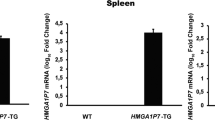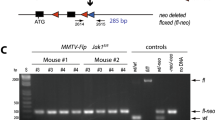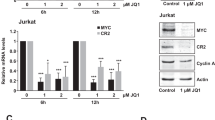Abstract
THE human proto-oncogene myc encodes a nuclear phosphoprotein whose primary biochemical function is still unknown1,2. To facilitate further study of that function, we have created conditional alleles of myc by fusing the hormone-binding domain of the human oestrogen receptor gene to the 5' or the 3' end of human myc. The two chimaeric genes, designated mycer and ermyc, encode proteins that bind oestrogen with high affinity. Expression of one of the genes, mycer, transforms a rat fibroblast cell line in a tightly oestrogen-dependent manner. Transformation is dependent on the presence of a functional myc gene in the chimaera and is reversible upon removal of the hormone. The chimaeric genes will be useful tools to study the mechanisms by which Myc affects cellular phenotype. Recently, chimaeras between the adenovirus El A protein and the hormone binding domain of the rat glucocorticoid receptor were shown to activate transcription in a manner characteristic for El A, but in a hormone regulated manner10. We there-fore asked whether the same strategy could be applied to the product of myc.
This is a preview of subscription content, access via your institution
Access options
Subscribe to this journal
Receive 51 print issues and online access
$199.00 per year
only $3.90 per issue
Buy this article
- Purchase on Springer Link
- Instant access to full article PDF
Prices may be subject to local taxes which are calculated during checkout
Similar content being viewed by others
References
Alitalo, K. et al. Nature 306, 274–277 (1983).
Hann, S. R., Abrams, H. D., Rohrschneider, L. R. & Eisenman, R. N. Cell 34, 789–798 (1983).
Kumar, V., Green, S., Staub, A. & Chambon, P. EMBO J 5, 2231–2236 (1986).
Dang, C. V. & Lee, W. M. F. Molec. cell. Biol. 8, 4048–4054 (1988).
Small, M. B., Hay, N., Schwab, M. & Bishop, J. M. Molec. cell. Biol. 7, 1638–1645 (1987).
von Weizsaecker, F., Beug, H. & Graf, T. EMBO J. 5, 1521–1527 (1986).
Webster, N. J. G., Green, S., Jin, J. R. & Chambon, P. Cell 54, 199–207 (1988).
Stone, J. et al. Molec. cell. Biol. 7, 1697–1709 (1987).
Brown, A. M. C. & Scott, M. R. D. in DNA Cloning, a Practical Approach Vol. 3 (ed. Glover, D. M.) 189–212 (Oxford. 1987).
Picard, D., Salser, S. J. & Yamamoto, K. R. Cell 54, 1073–1080 (1988).
Author information
Authors and Affiliations
Rights and permissions
About this article
Cite this article
Eilers, M., Picard, D., Yamamoto, K. et al. Chimaeras of Myc oncoprotein and steroid receptors cause hormone-dependent transformation of cells. Nature 340, 66–68 (1989). https://doi.org/10.1038/340066a0
Received:
Accepted:
Issue Date:
DOI: https://doi.org/10.1038/340066a0
This article is cited by
-
Target gene-independent functions of MYC oncoproteins
Nature Reviews Molecular Cell Biology (2020)
-
Rational design of genetically encoded reporter genes for optical imaging of apoptosis
Apoptosis (2020)
-
Interaction between the BAG1S isoform and HSP70 mediates the stability of anti-apoptotic proteins and the survival of osteosarcoma cells expressing oncogenic MYC
BMC Cancer (2019)
-
Nucleoli cytomorphology in cutaneous melanoma cells – a new prognostic approach to an old concept
Diagnostic Pathology (2017)
-
Regulation of MKL1 via actin cytoskeleton dynamics drives adipocyte differentiation
Nature Communications (2014)
Comments
By submitting a comment you agree to abide by our Terms and Community Guidelines. If you find something abusive or that does not comply with our terms or guidelines please flag it as inappropriate.



